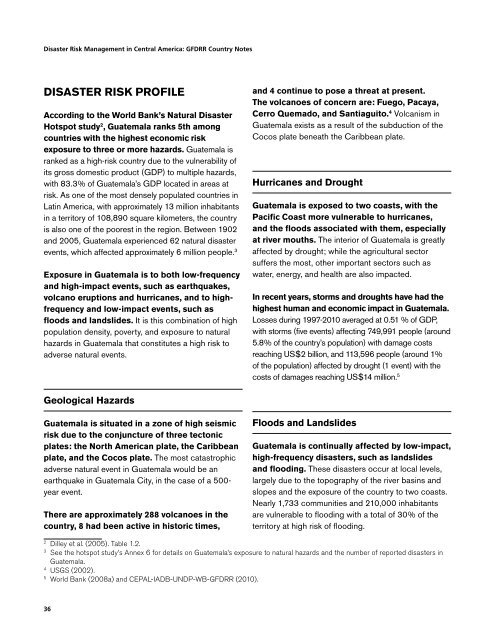Disaster Risk Management in Central America: GFDRR Country Notes
Disaster Risk Management in Central America: GFDRR Country Notes
Disaster Risk Management in Central America: GFDRR Country Notes
Create successful ePaper yourself
Turn your PDF publications into a flip-book with our unique Google optimized e-Paper software.
<strong>Disaster</strong> <strong>Risk</strong> <strong>Management</strong> <strong>in</strong> <strong>Central</strong> <strong>America</strong>: <strong>GFDRR</strong> <strong>Country</strong> <strong>Notes</strong><br />
disaster risk profile<br />
Accord<strong>in</strong>g to the World Bank’s Natural <strong>Disaster</strong><br />
Hotspot study 2 , Guatemala ranks 5th among<br />
countries with the highest economic risk<br />
exposure to three or more hazards. Guatemala is<br />
ranked as a high-risk country due to the vulnerability of<br />
its gross domestic product (GDP) to multiple hazards,<br />
with 83.3% of Guatemala’s GDP located <strong>in</strong> areas at<br />
risk. As one of the most densely populated countries <strong>in</strong><br />
Lat<strong>in</strong> <strong>America</strong>, with approximately 13 million <strong>in</strong>habitants<br />
<strong>in</strong> a territory of 108,890 square kilometers, the country<br />
is also one of the poorest <strong>in</strong> the region. Between 1902<br />
and 2005, Guatemala experienced 62 natural disaster<br />
events, which affected approximately 6 million people. 3<br />
Exposure <strong>in</strong> Guatemala is to both low-frequency<br />
and high-impact events, such as earthquakes,<br />
volcano eruptions and hurricanes, and to highfrequency<br />
and low-impact events, such as<br />
floods and landslides. It is this comb<strong>in</strong>ation of high<br />
population density, poverty, and exposure to natural<br />
hazards <strong>in</strong> Guatemala that constitutes a high risk to<br />
adverse natural events.<br />
and 4 cont<strong>in</strong>ue to pose a threat at present.<br />
The volcanoes of concern are: Fuego, Pacaya,<br />
Cerro Quemado, and Santiaguito. 4 Volcanism <strong>in</strong><br />
Guatemala exists as a result of the subduction of the<br />
Cocos plate beneath the Caribbean plate.<br />
Hurricanes and Drought<br />
Guatemala is exposed to two coasts, with the<br />
Pacific Coast more vulnerable to hurricanes,<br />
and the floods associated with them, especially<br />
at river mouths. The <strong>in</strong>terior of Guatemala is greatly<br />
affected by drought; while the agricultural sector<br />
suffers the most, other important sectors such as<br />
water, energy, and health are also impacted.<br />
In recent years, storms and droughts have had the<br />
highest human and economic impact <strong>in</strong> Guatemala.<br />
Losses dur<strong>in</strong>g 1997-2010 averaged at 0.51 % of GDP,<br />
with storms (five events) affect<strong>in</strong>g 749,991 people (around<br />
5.8% of the country’s population) with damage costs<br />
reach<strong>in</strong>g US$2 billion, and 113,596 people (around 1%<br />
of the population) affected by drought (1 event) with the<br />
costs of damages reach<strong>in</strong>g US$14 million. 5<br />
Geological Hazards<br />
Guatemala is situated <strong>in</strong> a zone of high seismic<br />
risk due to the conjuncture of three tectonic<br />
plates: the North <strong>America</strong>n plate, the Caribbean<br />
plate, and the Cocos plate. The most catastrophic<br />
adverse natural event <strong>in</strong> Guatemala would be an<br />
earthquake <strong>in</strong> Guatemala City, <strong>in</strong> the case of a 500-<br />
year event.<br />
There are approximately 288 volcanoes <strong>in</strong> the<br />
country, 8 had been active <strong>in</strong> historic times,<br />
Floods and Landslides<br />
Guatemala is cont<strong>in</strong>ually affected by low-impact,<br />
high-frequency disasters, such as landslides<br />
and flood<strong>in</strong>g. These disasters occur at local levels,<br />
largely due to the topography of the river bas<strong>in</strong>s and<br />
slopes and the exposure of the country to two coasts.<br />
Nearly 1,733 communities and 210,000 <strong>in</strong>habitants<br />
are vulnerable to flood<strong>in</strong>g with a total of 30% of the<br />
territory at high risk of flood<strong>in</strong>g.<br />
2<br />
Dilley et al. (2005). Table 1.2.<br />
3<br />
See the hotspot study’s Annex 6 for details on Guatemala’s exposure to natural hazards and the number of reported disasters <strong>in</strong><br />
Guatemala.<br />
4<br />
USGS (2002).<br />
5<br />
World Bank (2008a) and CEPAL-IADB-UNDP-WB-<strong>GFDRR</strong> (2010).<br />
36
















